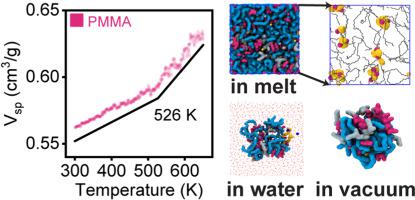Polymer ( IF 4.1 ) Pub Date : 2022-11-16 , DOI: 10.1016/j.polymer.2022.125503 Tianyi Jin , Shayna L. Hilburg , Alfredo Alexander-Katz

|
Random heteropolymers (RHPs) have a long history of being studied as toy models for protein folding. Previous computational studies applied statistical mechanics or coarse-grained methods to investigate the RHP phase transition; here, we use atomistic molecular dynamics (MD) simulations to explore the factors affecting the glass transition temperature (Tg) and the mobility of a complex class of RHPs. Our RHPs consist of four methyl methacrylate-based monomers with side chains mimicking different classes of amino acids. We explore the dynamical features in the RHP melts with random sequence mixtures and show that instead of a sharp pseudo-second-order glass transition, as for PMMA, RHPs with low ionic contents show a soft and gradual transition and those with increased content of ionic monomers show a sharp transition. Meanwhile, the configurational entropy of the backbone dihedral angle decreases suddenly in both PMMA and RHPs as a common signature of the glass transition. The dynamical spatial heterogeneity during the glass transition is related to both the chemical structure of the monomers and their positions along the chain. Moreover, chain mobility depends on the content of ionic monomers and types of counterions. The comparison with the single-chain nanoparticles (SCNPs) in water and in vacuum shows “breathing dynamics” with higher mobility. Our work characterizes the physicochemical properties of the RHP melts as a group of emerging bio-inspired polymer materials.
中文翻译:

随机杂聚物的玻璃化转变:熔体、水中和真空中的分子动力学模拟研究
随机杂聚物 (RHP) 作为蛋白质折叠的玩具模型进行研究已有很长的历史。以前的计算研究应用统计力学或粗粒度方法来研究 RHP 相变;在这里,我们使用原子分子动力学 (MD) 模拟来探索影响玻璃化转变温度 (T g) 和一类复杂的 RHP 的移动性。我们的 RHP 由四种基于甲基丙烯酸甲酯的单体组成,其侧链模仿不同类别的氨基酸。我们探索了具有随机序列混合物的 RHP 熔体中的动力学特征,并表明对于 PMMA,具有低离子含量的 RHP 显示出柔和且渐进的过渡,而不是尖锐的伪二级玻璃化转变,而离子含量增加的那些单体表现出急剧的转变。同时,作为玻璃化转变的共同特征,PMMA 和 RHP 中骨架二面角的构型熵突然减小。玻璃化转变期间的动态空间异质性与单体的化学结构及其在链上的位置有关。而且,链的流动性取决于离子单体的含量和抗衡离子的类型。与水中和真空中的单链纳米粒子 (SCNP) 的比较显示出具有更高流动性的“呼吸动力学”。我们的工作将 RHP 熔体的物理化学特性表征为一组新兴的仿生聚合物材料。











































 京公网安备 11010802027423号
京公网安备 11010802027423号